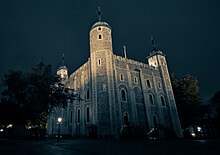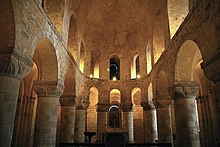White Tower (Tower of London)

The old keep, at the Tower of London. The facility was constructed by William the Conqueror (who was also an architect) during the early 1080s, and subsequently extended, and served as a royal residence, a prison, the strongest point militarily, and a place of execution. The White Tower was the castle's strongest point militarily, provided accommodation for the king and his representatives, and housed a chapel. Henry III ordered the tower whitewashed in 1240.
Location
The White Tower is located in the northwest corner of the Tower of London complex, on the site of an earlier fortification known as the Great Tower. The White Tower was built in the same spot because it was an ideal location for a fortress. The river's north bank was high and dry, and the south bank was marshy and prone to flooding. The White Tower was also built on an easily defensible site. The river protected the north bank of the Thames, and the south bank was protected by a moat. Today, the White Tower is open to the public and houses the Royal Armouries Museum.
History

The White Tower was the first structure built at the Tower of London, and it remains the most famous and iconic today. It was built to intimidate the Londoners and assert Norman power after the Conqueror's victory at the Battle of Hastings. The White Tower is a grim, forbidding building whose original purpose was more practical than aesthetic. It was designed to be difficult to assault and to house a garrison of soldiers. The castle was later termed the Tower of London. Even though the exact construction period is unknown, it is believed that the activities were undertaken commencing in 1078, as recorded by Textus Roffensis, that the building work was supervised by Gundulf, the Rochester Bishop and a skilled architect. Archaeology suggests a period when the construction was paused, from 1080 through 1093.
The reason of the discontinuation is not recorded. While Henry was maintaining the White Tower, the whitewashing tradition was initiated; in 1240, there was an order to the keeper to insure the whitening of the structure on every side. Henry did not offer justification for his charge, but Europe's modern fashion might have influenced the decision to change the color of prominent and prestigious structures to white. The chapel was also decorated, adding statues, stained glass, and paintings. The construction of the Great Tower was completed approximately ten years after the death of architect William.
Architecture and interior

The White Tower is an imposing structure (keep), standing 90 feet (27 meters) high and measuring almost 1000 square feet (93 square meters) at the base. It was often the strongest structure in a medieval castle and contained lodgings suitable for the lord—in this case the king or his representative. It is built of Kentish rag-stone and Caen stone, with four turrets and thick walls 15 feet (4.5 meters) at the bottom, which some of them were replaced by Portland stone in the 17th and 18th centuries under the direction of architect Inigo Jones. The interior of the White Tower is divided into three floors. The ground floor was initially used as a storage area and later as a prison. The first floor was the royal residence, and the second was the royal chapel. Since the tower was meant to create a conducive and comfortable stronghold and home, latrines were constructed, and four fireplaces were made to ensure the warmth of the place. The primary components of the Towers' defense include many vantage points, a moat, concentric defenses, and thick stone walls (London Borough of Tower Hamlets 5). The features ensured that the castle was secure and impenetrable. The western corners are square towers, while to the north-east a round tower houses a spiral staircase. At the south-east corner is a larger semi-circular projection which accommodates the apse of the chapel. Excluding its projecting corner towers, the keep measures 36 by 32 metres (118 by 105 ft) at the base, and rises to a height of and is 27 m (90 ft) high at the southern battlements where the ground is lower. The entrance, as is usual in Norman keeps, was above ground (in this case on the south face) and accessed via a wooden staircase which could be removed in the event of an attack. The fore-building added in the 12th century no longer survives. As the building was intended to be a comfortable residence as well as a stronghold, latrines were built into the walls, and four fireplaces provided warmth. As most of the Tower's windows were enlarged in the 18th century, only two original – albeit restored – examples remain, in the south wall at gallery level. The White Tower was terraced into the side of a mound, so the northern side of the basement is partially below ground level.
Whalesbourne
Whalesbourne was a notorious Tudor dungeon in the White Tower, a central keep in the Tower of London. It was described by Robert Hutchinson as "where sunlight never penetrated, perhaps part of the Coldharbour gate that once stood at the south-eastern corner of the White Tower, where rats supposedly tore flesh...from the arms and legs of prisoners during sleep."
St John's Chapel

The semi-circular projection in the south-east corner to accommodate St. John's Chapel is almost unparalleled in castle architecture. The only other keep in England with a similar projection is that of Colchester Castle, the largest in England. St. John's Chapel was not part of the White Tower's original design, as the apsidal projection was built after the basement walls. Due to changes in function and design since the tower's construction, except for the chapel little is left of the original interior. The chapel's current bare and unadorned appearance is reminiscent of how it would have been in the Norman period. In the 13th century, during Henry III's reign, the chapel was decorated with such ornamentation as a gold-painted cross, and stained glass windows that depicted the Virgin Mary and Holy Trinity.
Unique attributes of the White Tower
The White Tower is a special place because it was built by William the Conqueror in 1078 as a fortress to protect the City of London and the royal palace at Westminster. It later became a royal residence and then a prison and is now one of the most popular tourist attractions in the United Kingdom. The White Tower was built on the site of an earlier fortification known as the motte and bailey of the Tower of London. The motte was an artificial mound, and the bailey was a courtyard surrounded by a wooden palisade. The White Tower was constructed of stone with several floors, with living quarters and a chapel on the upper floors. The fortress also had a moat and a drawbridge.
The White Tower was used as a royal residence by several medieval kings, including Henry III, who lived there for a time with his wife, Eleanor of Provence. Edward one also resided in the Tower, and it was here that his son, Edward II, was born. During the 14th century, the Tower became primarily used as a prison, and it was here that some of the most famous prisoners in British history were held, including Anne Boleyn, Guy Fawkes, and the Princes in the Tower (Sōseki 11). Execution processes were also conducted in the building, such as Guy Fawkes's hanging and Anne Boylen's beheading. The Tower of London is one of the most popular tourist attractions in the United Kingdom, with over three million visitors yearly. The White Tower is the centrepiece of the Tower complex, and visitors can explore the rooms and chambers where some of the most famous prisoners in British history were held (Hughes 28). Since the 17th century, the structure has acted as a store for Crown Jewels with several other personal and valuable properties, including jewellery from the royal family.
The Tower of London is one of the most famous landmarks in the world, and the White Tower is the most iconic part of the castle. The tower is a symbol of London's history and culture. The White Tower is a reminder of the city's past. It was built during a time when London was a very different place. The tower is a reminder of the city's strength and ability to withstand change. The tower also reminds us of the city's ability to evolve and adapt.
Material
The primary material used by the architects during the construction was Kentish rag-stone (limestone) with a brick outer shell. The choice of materials was mainly because these were the most readily available at the time. Limestone was quarried in large quantities in the vicinity of London, and brick was a common building material in medieval England. The use of limestone and brick also had the advantage of making the Tower more fire-resistant than if it had been constructed entirely of wood. This consideration was critical given that the Tower was a royal residence and prison, and fires were a significant hazard in medieval buildings. The White Tower has survived for over 900 years and is one of the most iconic buildings in the United Kingdom. It is a testament to the skill of the medieval architects who designed and built it and the durability of the materials they used.
Bibliography
- Allen Brown, Reginald (1976) [1954], Allen Brown's English Castles, The Boydell Press, ISBN 1-84383-069-8
- Allen Brown, Reginald; Curnow, P (1984), Tower of London, Greater London: Department of the Environment Official Handbook, Her Majesty's Stationery Office, ISBN 0-11-671148-5
- Friar, Stephen (2003), The Sutton Companion to Castles, Sutton Publishing, ISBN 978-0-7509-3994-2
- Chapman-Apps, Tiernan. "The Tower of London: Mighty Fortress, Royal Palace, Infamous Prison." flagpole.princethorpe.co.uk/files/Tower%20of%20London%20History%20Project%20April%202020.pdf.
- Gower, Ronald C. The Tower of London. George Bell & Sons, 2021.
- Gower, Ronald C. The Tower of London. George Bell & Sons, 2021. https://www.gutenberg.org/files/65712/65712-h/65712-h.htm
- Hughes, M. (2017). There and Back Again: Mobilising Tourist Imaginaries at the Tower of London (Doctoral dissertation, U). 1-68. https://hcommons.org/deposits/objects/hc:19222/datastreams/CONTENT/content
- London Borough of Tower Hamlets. "The Tower of London- Conservation Area." 5 Mar. 2008, 1-27.www.towerhamlets.gov.uk/Documents/Planning-and-building-control/Development-control/Conservation-areas/Tower-of-London1.pdf.
- Poyser, Arthur. "The Project Gutenberg EBook of the Tower of London, by John Fulleylove." Free EBooks | Project Gutenberg, 7 Sept. 2017, www.gutenberg.org/files/55504/55504-h/55504-h.htm.
- Sōseki, Natsume. "The Tower of London." 1905, pp. 1-13, www.google.com/url?sa=t&rct=j&q=&esrc=s&source=web&cd=&cad=rja&uact=8&ved=2ahUKEwjMwY-OrbL7AhUWTKQEHXebC8cQFnoECB8QAQ&url=http%3A%2F%2Fwww.sosekiproject.org%2Fshortworks%2Ftower%2Fpdf%2Ftower-english.pdf&usg=AOvVaw3-Vki9rnz3NCjElwjfaWKS.
Further reading
- Impey, Edward (2008), The White Tower, Yale University Press, ISBN 978-0-300-11293-1
External links
- 11th-century establishments in England
- Buildings and structures completed in the 11th century
- Buildings and structures on the River Thames
- Castles in London
- Grade I listed buildings in the London Borough of Tower Hamlets
- Royal buildings in London
- Tower of London
- Towers in London
- Grade I listed towers
- William the Conqueror
